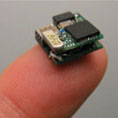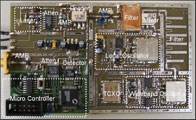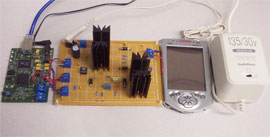Contact Information
Component-based design of Embedded Systems
phchou@uci.edu
(949) 824-3229
https://engineering.uci.edu/users/pai-chou
Professor Chou’s Research
View his Publications and Research Gate profile.
Current Funding
- (7/2014) NIH SBIR Phase 2 on ECG for Long-QT screening.
- (7/2015) NIH SBIR Phase 1 of BlueBox recorder
- (9/2015) NIH SBIR Phase 1 of system for asthma assessment
Research Interests
Chou’s area of research covers hardware/software codesign of embedded systems, with a particular emphasis on low-power and power-aware system designs. His effort can be divided into two complementary areas: design tools and system designs. The tools improve system designs systematically, while system designs provide motivating examples for the tools. He also has several interdisciplinary collaborations with civil engineering, mechanical engineering, and medicine.
He has been developing Integrated Management Power Aware Computing and Communication Technologies (IMPACCT), a computer-aided design (CAD) tool for exploring power-management policies at the application and architecture levels. The goal of the project is to improve power and performance for mission-critical systems, including the Mars Rover project by NASA/JPL and Rockwell Collin’s software defined radio systems.
Chou is currently developing a number of embedded instruments. One is the B# battery emulator, which is a smart power supply that mimics the power output of a battery. Another embedded instrument is the mini-FDPM breast cancer detector in collaboration with the Beckman Laser Institute. He is also building wireless sensor nodes for monitoring structural health of building structures.
Recent Projects
- Next Generation SCADA for Prevention and Mitigation of Water System Infrastructure Disaster
- Coastal underwater sediments tracking
- ECG Device for Long QT Syndrome Screening in Newborn
- Infant Sleep Environment Monitoring System (SEMS) for SIDS (Sudden Infant Death Syndrome)
Past Projects
Wireless Embedded Sensing Systems
Key Researcher: Chulsung Park, Keun Sik NoWireless sensor nodes received much attention recently due to the rich set of research topics, crosscutting impact, and broad funding opportunities. Our contributions have been to build the hardware systems that can actually work under the most extreme of conditions, including power availability, form factor, and precise timing. We have worked with faculty members in other engineering departments at UCI to build up the solid foundation for deploying wireless sensor nodes in many applications.DuraNode (2003–)The first sensor node is called DuraNode, a wireless sensor node for monitoring the structural health in civil engineering. It is a new solar-powered sensor node that overcame many engineering challenges in power management, real-time scheduling, and communication protocols. The result was a durable, robust wireless sensor system that can collect data and transmit the results in real-time over a wireless Internet connection. This sensor node has been demonstrated in April 2004 on the green steel bridge on East Peltason Dr., UCI, and will be deployed throughout the new Cal(IT)2 building. This sensor node design not only provides a brand new technology for civil engineering, but it also encompasses many innovations in electrical and computer engineering, including impedance matching with the solar panel by dynamic power management and reduction of power fragmentation with multiple ambient power sources. In November 2004, a new dual-microcontroller DuraNode has been constructed and demonstrated at the Cal(IT)2 open house. It supports low-jitter operation, aggressive power management capabilities, and ability to interface with sensors with very different voltage levels.
structural health in civil engineering. It is a new solar-powered sensor node that overcame many engineering challenges in power management, real-time scheduling, and communication protocols. The result was a durable, robust wireless sensor system that can collect data and transmit the results in real-time over a wireless Internet connection. This sensor node has been demonstrated in April 2004 on the green steel bridge on East Peltason Dr., UCI, and will be deployed throughout the new Cal(IT)2 building. This sensor node design not only provides a brand new technology for civil engineering, but it also encompasses many innovations in electrical and computer engineering, including impedance matching with the solar panel by dynamic power management and reduction of power fragmentation with multiple ambient power sources. In November 2004, a new dual-microcontroller DuraNode has been constructed and demonstrated at the Cal(IT)2 open house. It supports low-jitter operation, aggressive power management capabilities, and ability to interface with sensors with very different voltage levels.
Eco (2004–)
 The second sensor node is called Eco, a world record setter for being the smallest wireless sensor node to date. Only 557mm3 in volume and 1.6 grams in weight, Eco is designed to be worn on the limbs of pre-term infants to monitor their spontaneous movement in response to assisted exercises. Professor Andrei Shkel of Mechanical Engineering, an expert on sensor devices, was working with UCI Medical researchers on this problem, and we designed this ultra-compact sensor node that is only 11% the volume of the smallest of the most popular commercial sensor node, the Mica2DOT from Crossbow.
The second sensor node is called Eco, a world record setter for being the smallest wireless sensor node to date. Only 557mm3 in volume and 1.6 grams in weight, Eco is designed to be worn on the limbs of pre-term infants to monitor their spontaneous movement in response to assisted exercises. Professor Andrei Shkel of Mechanical Engineering, an expert on sensor devices, was working with UCI Medical researchers on this problem, and we designed this ultra-compact sensor node that is only 11% the volume of the smallest of the most popular commercial sensor node, the Mica2DOT from Crossbow.
Medical Instrumentation: Mini-FDM Mini-FDPM is a noninvasive, optical handheld breast-cancer detector based on the principles of frequency domain photon migration (FDPM), developed at UCI. Our handheld unit is smaller, higher performance, and significantly lower cost than current systems, making it practical for replication and wide distribution. This work also lays the foundation for research on a system-on-chip implementation and FDPM-based imaging system.
Mini-FDPM is a noninvasive, optical handheld breast-cancer detector based on the principles of frequency domain photon migration (FDPM), developed at UCI. Our handheld unit is smaller, higher performance, and significantly lower cost than current systems, making it practical for replication and wide distribution. This work also lays the foundation for research on a system-on-chip implementation and FDPM-based imaging system.
Energy Harvesters: Ambimax, Everlast, DuraCap, EscaCap
Key References: C. Park, J. Liu, and P. Chou, “Eco: an Ultra-Compact Low-Power Wireless Sensor Node for Real-Time Motion Monitoring,” to appear, in Proceedings of The Fourth International Conference on Information Processing in Sensor Networks, April 25-27, 2005. UCLA. H. Chung, C. Park, Q. Xie, P. H. Chou, M. Shinozuka, “DuraNode: wireless network sensor for structural safety monitoring,” in Proceedings of SPIE Nondestructive Detection and Measurement for Homeland Security III Conference, Vol. 5769, San Diego, March 7-9, 2005.K. No, P. Chou, “Mini-FDPM: a Handheld Non-Invasive Breast Cancer Detector Based on Frequency Domain Photon Migration,” in Proc. IEEE BioCAS, Singapore, December 1–3, 2004. pp. 2.2-5 — 2.2-8.download pdfP. Chou, D. Li, “Maximizing Efficiency of Solar-Powered Systems by Load Matching”, in Proc. International Symposium on Low Power Electronic Design (ISLPED), Newport Beach, August 9-11, 2004. pp. 162–167.
download pdfC. Park, P. Chou, “Power Utility Maximization for Multiple-Supply Systems by a Load-Matching Switch”, in Proc. International Symposium on Low Power Electronic Design (ISLPED), Newport Beach, August 9-11, 2004. pp. 168–173.
download pdf
Design Tool for Power Aware Embedded Systems
Key researchers: Jinfeng Liu, Dexin Li, Jiwon Hahn, Qiang XieIMPACCT is the name of the design tool for Integrated Management of Power Aware Computing and Communication Technologies. During Phase 1 (2000-2002), IMPACCT focused on constraint-driven power-aware scheduling and system-level mode-dependency modeling. For data regular applications, power-aware task motion applies software pipelining towards satisfaction of timing and power constraints. Communication speed in a multi-speed interface was considered as a knob for power management with simultaneous functional partitioning among multiple voltage-scalable CPUs and data compression more recently. The target applications included NASA/JPL’s Sojourner Mars Pathfinder and ATR (automatic target recognition) algorithms.For phase 2 of the PAC/C program, we work with Rockwell Collins to reduce power in their software-defined radios (SDR). A new tool called ImpacctPro was developed to enables designers of a software-defined radio (SDR) to explore many options in improving power efficiency. The tool supports high-level modeling of the sytem architecture, tasks, real-time scheduling, power management, co-simulation, and profiling. Innovations include
- Generalized, multiple power-mode dynamic power management that subsumes the traditional break-even time analysis. We use a novel energy-over-time geometric formulation for optimization on multi-mode transition sequences.
- ability to control an SDR system in real-time, so that the system can be tested and measured while operating normally.
- ultra-fast and efficient evolutionary algorithm for slack distribution. It uses very few voltage/frequency steps to accomplish the same level of energy saving as the best published but slow technique, while running hundreds of times faster.
download pdfJ. Liu and P. Chou, Energy Optimization of Distributed Embedded Processors by Combined Data Compression and Functional Partitioning, in Proc. International Conference on Computer-Aided Design (ICCAD), November 9-13, 2003. pp.201–208.
download pdfD. Li, Q. Xie, P. Chou, Scalable Modeling and Optimization of Mode Transitions Based on Decoupled Power Management Architecture, in Proc. Design Automation Conference (DAC), Anaheim, CA, June 2003. pp. 119–124.
downlaod pdfJ. Liu, P.. Chou and N. Bagherzadeh, Combined Functional Partitioning and Communication Speed Selection for Networked Voltage-Scalable Processors, in Proceedings of the International Symposium on System Synthesis, October 2002. pp. 14–19.J. Liu, P. Chou and N. Bagherzadeh, Communication Speed Selection for Embedded Systems with Networked Voltage-Scalable Processors, Proceedings of the 10th International Symposium on Hardware/Software Codesign (CODES’02), Estes Park, CO, May 2002. pp. 169–174.
download pdfJ. Liu, Pai H. Chou, and N. Bagherzadeh, “Power-Aware Task Motion for Enhancing Dynamic Range of Embedded Systems with Renewable Energy Sources,”, in Lecture Notes in Computer Science (LNCS), Springer-Verlag, 2002. pp. 84–99.P. Chou, J.g Liu, D. Li, and N. Bagherzadeh, IMPACCT: Methodology and Tools for Power-Aware Embedded Systems, in Design Automation for Embedded Systems, Kluwer Design Automation of Embedded Systems, October 2002. pp. 205–232.
download pdf
Power Instrumentation
Key researchers: Chulsung Park, Jinfeng LiuB# (pronounced “B-sharp”) is a system that can perform battery emulation and power profiling. The novelty is the combination of the hardware and software: the hardware controls the electrical property, while the software defines the behavior by real-time simulation of the battery chemistry. The most important value of B# is reproducibility: it enables experiments involving embedded systems that track power levels to behave exactly the same way each time. This concept has been extended from lithium-ion batteries to solar panels and fuel cells.
 The B# system is available to research groups in academia and industry, and the software is freely downloadable on the Internet for academic research use. We have developed the world’s most accurate (1% error) battery models that have been calibrated and validated empirically with B#. This is a unique capability that it is needed by many. The novelty of this work was recognized with the Low Power Design Contest Award at the International Symposium on Low Power Electronics and Design (ISLPED) 2003. It carried a $2,000 cash award and was one of the six winning entries out of 16 submissions worldwide.
The B# system is available to research groups in academia and industry, and the software is freely downloadable on the Internet for academic research use. We have developed the world’s most accurate (1% error) battery models that have been calibrated and validated empirically with B#. This is a unique capability that it is needed by many. The novelty of this work was recognized with the Low Power Design Contest Award at the International Symposium on Low Power Electronics and Design (ISLPED) 2003. It carried a $2,000 cash award and was one of the six winning entries out of 16 submissions worldwide.
download pdf

